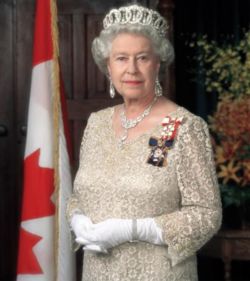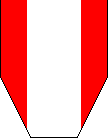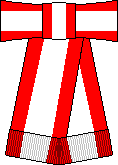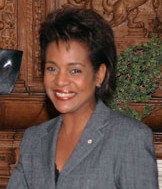Order of Canada
2007 Schools Wikipedia Selection. Related subjects: Military History and War
The Order of Canada is Canada's highest civilian honour, with membership awarded to those who exemplify the Order's Latin motto Desiderantes meliorem patriam, which means "(those) desiring a better country." Created in 1967, the Order was established to recognize the lifetime contributions made by Canadians who made a major difference to Canada. The Order also recognizes efforts made by non-Canadians who have made the world better by their actions. Musicians, politicians, artists, television and film stars, benefactors, and many more have been accepted into the Order. The Queen of Canada, Queen Elizabeth II, is Sovereign of the Order and the serving Governor General of Canada is its Chancellor and Principal Companion. Since 1967, 5053 people have been appointed to the Order of Canada.
Creation

The Order of Canada was instituted on April 17, 1967, by Queen Elizabeth II, on the advice of Prime Minister Lester Pearson. The Order was created to recognize exemplary achievement and service to Canada, by Canadians. The awards were officially launched on July 1, 1967, during the 100th anniversary celebrations of the formation of the Dominion of Canada. Governor General Roland Michener was the first inductee to the order, with 90 more people appointed on 7 July 1967. The creation of the Order was the beginning of the establishment of the Canadian honours system, a system of awards and decorations to be bestowed onto Canadians and foreigners. Upon the creation of the system, it broke off the dependence of the honours system used by the United Kingdom and by some of its former Crown colonies and dominions. Before the Order of Canada was created, the main order presented to Canadians for the above criteria was the Order of the British Empire. The first appointee (selection) and investiture (inducting) was for Roland Michener, the twentieth Governor General of Canada, to the level of Companion. Other first appointees included Vincent Massey, Louis St. Laurent, Hugh MacLennan, Father David Bauer, Gabrielle Roy, Donald Creighton, Thérèse Casgrain, Wilder Penfield, Arthur Lismer, and Maurice Richard. The Queen was presented with the Sovereign's badge by Governor General Roland Michener during a visit to London, England, in 1967, and she first wore it during a banquet in Yellowknife in July 1970.
Since the Order of Canada was created, Australia has created a system of awards based on the Order of Canada: the Order of Australia. However, the Order of Australia has been awarded more liberally, especially to foreigners, than has the Order of Canada. In 1996, New Zealand created the New Zealand Order of Merit, a five-level order of chivalry modelled on the Order of the British Empire. The Order of New Zealand is modelled on the Order of the Companions of Honour and the Order of Merit.
Grades
There are three grades (levels) of the Canadian Order: Companion (highest), Officer, and Member, each with respective post-nominal letters that its members are entitled to use. Promotions in grade are possible; typically, this is not done until at least five years after the initial appointment. For example, film director Denys Arcand was promoted from Officer to Companion. Originally, the Order had only two ranks, Companion and the Medal of Courage (now the Cross of Valour). On July 1, 1972, the levels of Officer and Member were introduced and all existing members were made Officers.
Companion
Companions of the Order of Canada (post-nominal: C.C.) have demonstrated the highest degree of merit to Canada and humanity, on the national or international scene. Up to 15 Companions are appointed each year, with a limit of 165 living Companions at any given time, with the exception of honorary Companions. As of September 29, 2005, there were 166 living Companions, including four honorary Companions. However, the appointment of Michaëlle Jean to the position of Governor General made her the 164th living Companion. The Constitution of the Order of Canada also allows for the spouse of the Governor General to be appointed a Companion, so Jean-Daniel Lafond is the 165th living Companion. On February 3, 2006, Rideau Hall announced that Bernard Ostry and David Suzuki would be made companions.
Officer
Officers of the Order of Canada (O.C.) have demonstrated an outstanding level of talent and service to Canadians. Up to 64 Officers are appointed each year. As of September 29, 2005, there were 1006 living Officers, although there is no limit to how many may be living at one time.
Member
Members of the Order of Canada (C.M.) have made an exceptional contribution to Canada or Canadians at a local or regional level, group, field or activity. As many as 136 Members may be appointed annually and there is no limit on how many Members may be living. As of September 29, 2005, there were 1,964 living members.
| Companion | Officer | Member |
|---|---|---|
 |
 |
 |
| Ribbon Bar | ||
Insignia
The badge of the Order is a white enamelled snowflake design, in gilt for Companions and Officers, and in silver for Members. The central disc bears a maple leaf, in red enamel for Companions, in gold for Officers, and in silver for Members, all on a white enamel background, surrounded by a red enamel ring (annulus) bearing the motto of the Order, and topped by a crown of St. Edward. The reverse is plain except for the word "Canada". The ribbon is white bordered in red stripes, similar to the Canadian flag.
The insignia can be passed down as a family heirloom but cannot be sold. When a member of the order is upgraded to a higher rank that individual must return their original emblem to the Chancellery.
The medal (as well as the majority of the ensuing emblems in the Canadian honour system) was designed by Bruce W. Beatty, who as of 2004 has been in attendance at every investiture ceremony since 1967. Beatty was himself made a member of the Order in 1990.
When wearing medals and decorations, the Order of Canada is worn before all national orders and nearly all other Canadian decorations: only the Victoria Cross and the Cross of Valour are worn before the Order of Canada. The grades of Companion and Officer have their medals worn by a neck ribbon, while the Member grade is displayed on a chest ribbon on the left side of the jacket. Until recently, women appointees had to wear a ribbon bow in order to display the Order, which was positioned to the left. Other than on special occasions laid out by the Governor General, women wear their Order by the same means as the men, although current governor general Michaëlle Jean has taken to displaying the order with the female bow. The chest ribbon is the same for each grade, save for a metallic maple leaf in the centre, the colour of which depends on the grade that one was appointed to: red for a Companion, gold for an Officer, silver stands for a Member. Each appointee is also granted the right to ask for coat of arms from the Canadian Heraldic Authority if one does not exist for them. Companions can ask the Authority for the use of supporters on their personal coat of arms. The Order motto (in gold lettering on a red background) is circled around the shield, while the Order medal is suspended from the base of the shield. Because the Queen is sovereign of the Order, the current Coat of Arms of Canada, in use since 1994, uses the red ribbon with the Order motto in gold. For civilian wear, a lapel pin is worn on the jacket, which is designed as a miniature of the medal design. An example of one being used is shown in this photo of Roméo Dallaire, O.C. The Governor General also wears a special chain during certain ceremonies. The chain consisted of the Companion medal, suspended from the shield of Canada, submitted by the crown. On each side, the necklace is composed of two repeating elements: a white stylized snowflake and the central disc that appears on the Companion medals. At the Governor General's installation ceremony he or she is presented with the Chain of the Order of Canada and the Order of Military Merit.
| C.C. & O.C. Ribbon | C.M. Ribbon | Female Bow | Coat of Arms | Lapel Pin |
|---|---|---|---|---|
 |
Image:Rae image.jpg
|
Eligibility
All living Canadians are eligible for any of the three awards, except federal and provincial politicians and judges while they are holding office. Awards are announced twice annually, once around New Year's Day ( January 1) and again around Canada Day ( July 1). Appointees who have died before their investiture are still considered part of the Order. Multiple people who have committed the same honourable act or deed are eligible for induction. For example, all three members of the Canadian band Rush ( Geddy Lee, Alex Lifeson and Neil Peart) have all been appointed Officers of the Order, the first time the Order of Canada was given to a group rather than an individual. All three members of the popular children's group Sharon, Lois & Bram ( Sharon Trostin Hampson, Lois Lilienstein & Bramwell Morrison) have also been made member of the order - although since Lilienstein is an American citizen she was made an honorary member (see below).
Citizens of other countries are eligible for honorary appointments at all three levels. No more than five honorary appointments may be made in any year.
Induction ceremonies are generally conducted by the Governor General at Rideau Hall in Ottawa or, on rare occasions when she is in the country, by the Queen herself. The most common reason for the Order not being presented at Rideau Hall is the recipient's inability to come to Ottawa. An early example of this occurred in 1980 when activist athlete Terry Fox was dying of terminal cancer. A more recent example occurred in 2003 with singer-songwriter Gordon Lightfoot In 2002, shortly before a concert, Lightfoot suffered a serious abdominal haemorrhage that resulted in his being in a coma for a time and months in hospital recovering. On the news of his near-death condition, Lightfoot was promoted to the rank of Companion. Since his condition left him unable to travel, Adrienne Clarkson flew to Toronto and presented him with the insignia in a private ceremony performed in his hospital room.
Another example is Her Majesty Queen Elizabeth, the Queen Mother: in 2000, at the age of 100, Her Majesty was invested as an Honorary Companion at Clarence House in London. Rather than place the insignia on the Queen Mother, who was recovering from a hip replacement, Clarkson handed Her Majesty her medallion. Her Majesty made a point of wearing it around her neck at a special lunch following the private ceremony.
Prior to Adrienne Clarkson becoming Governor General of Canada, The Order of Canada was rarely awarded outside of Rideau Hall or the Governor General's secondary residence La Citadelle. Under her tenure Clarkson held entire investment ceremonies in cities like St. John's, Newfoundland and Vancouver, British Columbia. She was also noted for delegating the duty to other individuals on certain occasions when it would have been difficult for her or the recipient to travel.
Although inductions are usually performed by the Governor General, the task can be delegated to another individual, such as the Lt. Governor of a Canadian province. This was the case when Mervyn Wilkinson was inducted into the order by Iona Campagnolo the Lieutenant Governor of British Columbia in 2002.
Although sitting federal and provincial politicians cannot be appointed to the Order while in office, it is accepted that influential leaders such as former prime ministers will be appointed after they leave office. In fact, of all the prime ministers alive after the creation of the order (with the exception of recent and current Prime Ministers Kim Campbell, Jean Chrétien, Paul Martin and Stephen Harper), the only prime minister who was not appointed to the Order was John Diefenbaker. After losing the office of the Prime Minister to Lester B. Pearson in 1963 Diefenbaker remained a sitting Member of Parliament and died while still in office in 1979, never becoming eligible. Some prominent politicians such as former NDP leader Ed Broadbent and former Prime Minister Joe Clark were appointed after exiting politics, only to later return to elective office.
In the same vein as Prime Ministers being appointed after leaving office, all Chief Justice of Canada from Robert Taschereau onward have been made Companions. The only one not appointed is Beverly McLachlin who is the current Chief Justice of the Supreme Court of Canada.
Although sitting politicians cannot be appointed to the order while in office, individuals who hold a ceremonial political office (for example a Sergeant-at-arms) are considered public servants and therefore can be invested while serving in that office.
Senators cannot be appointed while they hold office, however, there have been several senators who were appointed to the Order prior to taking office. Currently there are 13 Senators who hold the Order. They are (in alphabetical order) Tommy Banks, Michel Biron, Ione Christensen, Roméo Dallaire, Trevor Eyton, Serge Joyal, Wilbert Keon, Jean Lapointe, Sandra Lovelace Nicholas, Frank Mahovlich, Donald Oliver, Nancy Ruth, and Hugh Segal.
A new member whose appointment is approved during their lifetime, but who dies prior to the announcement of that appointment or their investiture, may be invested posthumously. The 2005 appointment of journalist Peter Jennings was announced under these circumstances; his family will accept the award on his behalf.
The oldest person ever to be invested into the Order was Dr. Cornelius Wiebe, who was 106 years old when he was invested in 1999.
Removal
Members can be removed from the Order if the Advisory Council feels their actions have brought it into disrepute. As of 2006, only two people have their Order of Canada stripped from them: Alan Eagleson and David Ahenakew. Eagleson was removed from the order after being jailed for fraud in 1998. Ahenakew began facing calls for his removal due to anti-Semitic comments he made in 2002. After being convicted on charges of wilfully promoting hatred, the Governor General and the Advisory Council told the CBC that Ahenakew will be stripped of his honour and gave him the option to surrender his badge. On 11 July 2005, the Governor General signed an order, called a revocation ordinance, stripping Ahenakew of his membership in the Order of Canada. (In 2006 the Court of Queen's Bench for Saskatchewan, sitting on appeal of the Provincial Court decision, ordered a retrial of Ahenakew's hate crime conviction on the grounds that criminal intent had not been properly considered by the trial judge, and the Crown has chosen to take the appeal to the Court of Appeal for Saskatchewan. The Governor General's office declared that this did not change the finding that he had brought the Order of Canada into disrepute and should be expelled.)
In order for a person to be stripped of their honour, the Advisory Council must agree to the removal, the sending a letter to the person telling them of their decision. In this same letter, the Council also gives the person a time to respond to the decision. In the case of Ahenakew, a registered letter was sent to him asking for a response to their idea of taking his honour away. Ahenakew, who had until 9 July 2005 to respond, refused to do so. That led the Governor General to sign the above order on 11 July to take away his honour. Ahenakew is now required to surrender his medal and his civilian lapel pin. While there are no formal rules the Council has to retrieve the insignia, Ahenakew's lawyer Doug Christie said that "I think that once you are given a gift, and it is a gift, I don't think anyone can ask for it back," implying that Ahenakew has the right to keep his items. However, the author of the book The Order of Canada: Its Origins, History and Development, Christopher McCreery, said that since the government owns the medal and the scrolls, the Royal Canadian Mounted Police can be sent and get the items by force. McCreery stated that he does not think the RCMP would be used in Ahenakew's situation.
Advisory Council
The task of the Advisory Council is to evaluate the nominations of people to the Order and see if the nominated people are worthy enough to be accepted into the Order. The Governor General of Canada makes the appointments to the Order based on recommendations from the Advisory Council. The Secretary General to the Advisory Council announces the decision of the Advisory Council to the Canada Gazette and to the public about any appointments and dismissals from the Order.
The Advisory Council, which is chaired by the Chief Justice of Canada, includes the Clerk of the Privy Council, the Deputy Minister of the Department of Canadian Heritage, the Chairperson of the Canada Council for the Arts, the President of the Royal Society of Canada, and the Chairperson of the Association of Universities and Colleges of Canada. As well, five members of the Order are part of the Council for a maximum three-year term. If the nomination involves a non-Canadian, the Deputy Minister of the Department of Foreign Affairs and International Trade will be invited by the Advisory Council to evaluate the nomination.
The current members of the Advisory Council are:
- The Honourable Thomas R. Berger, O.C.
- Dr. Patricia A. Demers, President, the Royal Society of Canada
- Mr. Richard Francis Haskayne, O.C.
- Mr. Kevin G. Lynch, Clerk of the Privy Council and Secretary to the Cabinet
- Mr. Tom Jackson, O.C.
- Ms. Karen Kain, C.C., Chair, the Canada Council for the Arts
- Ms. Judith A. LaRocque, C.V.O., FRHSC (hon) Deputy Minister of Canadian Heritage
- Dr. Daurene E. Lewis, C.M.
- The Right Honourable Beverley McLachlin, P.C., Chief Justice of Canada (Chair)
- M. L. Jacques Ménard, O.C.
- Ms. Bonnie M. Patterson, Chairman of the Board, Association of Universities and Colleges of Canada
Appointments
Members can be found in Category:Members of the Order of Canada and citation can be found on the Order of Canada database at gg.ca.
Non-Canadian/Honorary appointments
As of 2006, there have been only twelve honorary appointments to non-Canadians, and one appointee has surrendered his Canadian citizenship. They are as follows:
Companion
- Nelson Mandela, the former President of South Africa (actually an honorary Canadian citizen) (1998)
- HM Queen Elizabeth, The Queen Mother, former Queen Consort of Canada (2000) (deceased)
- Boutros Boutros-Ghali, former Secretary-General of the United Nations (originally from Egypt) (2004)
- Václav Havel, President of the Czech Republic (2004)
- His Highness the Aga Khan, Imam of the Shia Imami Ismaili Muslims (2005)
Officer
- Professor John Kenneth Galbraith, influential American economist; born in Ontario, but renounced his status as a British subject ( Canadian citizenship did not exist until 1947) in August 1937 when he became a US citizen (1997) (deceased)
- James Hillier, inventor of the electron microscope (1997)
- Charles Dutoit conductor of the Montreal Symphony Orchestra (appointed 1997, invested 2002)
- Tanya Moiseiwitsch, British Theatre actress - a popular performer at the Stratford Festival (2003) (deceased)
Member
- Lois Lilienstein Member of Sharon, Lois & Bram - an American citizen. (2003)
- Francis Cabot Influential Gardener/Horticulturalist (2005)
- Salome Bey Musician (2006)
Other
Media baron Conrad Black became an Officer of the Order of Canada in 1990, but surrendered his Canadian citizenship to become a British life peer in 2001. Nevertheless, he remains in both the Order of Canada and the Queen's Privy Council for Canada.
Provincial and territorial orders
Various Canadian provinces and territories have also created orders to award their citizens on great deeds:
- Alberta Order of Excellence
- Order of British Columbia
- Order of Manitoba
- Order of New Brunswick
- Order of Newfoundland and Labrador
- Order of Nova Scotia
- Order of Ontario
- Order of Prince Edward Island
- National Order of Quebec
- Saskatchewan Order of Merit
- Yukon Territory Order of Polaris
Each province sets up its own rules on how membership in its order is awarded, though there is no rule that Order of Canada members cannot be inducted to provincial and territorial orders. Limitations on the number of provincial order inductions every year by certain provinces has led to this being more common for people from some provinces than from others. An example would be Gordon Lightfoot being a Companion of the Order of Canada and a member of the Order of Ontario (O. Ont.). The Order of Ontario places no limit on the annual number of inductions (although it is usually around 25). The Alberta Order of Excellence is limited to 10 inductees each year. One of the few Albertans to be part of the provincial and Canadian orders is former prime minister Joe Clark. It is also possible to receive multiple provincial orders. For example Canadian Jazz great Oscar Peterson who was born in Montreal but now lives in Ontario is a Companion of the Order of Canada, Knight of the National Order of Quebec, and a member of the Order of Ontario.
Additional decorations
At certain periods, holders of the order were presented with other decorations. These are usually commemorative medals. Thus far, four commemorative medals have been given automatically to every living member of the Order of Canada, or the Canadian Bravery Decorations:
- Canadian Centennial Medal (1967)
- Queen Elizabeth II Silver Jubilee Medal (1977)
- 125th Anniversary of the Confederation of Canada Medal (1992)
- Queen Elizabeth II's Golden Jubilee Medal (2002)
Other provincial commemorative medals such as the Alberta Centennial Medal and the Commemorative Medal for the Centennial of Saskatchewan require independent nomination.
Nomination forms
Nomination forms may be obtained by writing to The Chancellery, Rideau Hall, 1 Sussex Drive, Ottawa, Ontario CANADA, K1A 0A1.. Postage is free when mailed within Canada. Alternatively, nomination forms may be obtained in PDF format from the Governor General's Official Website. Photocopies of nomination forms are also accepted by the Chancellery Office.



